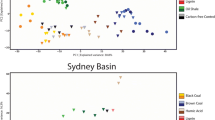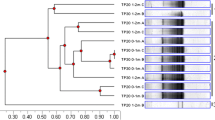Abstract
The abundance and distribution of microorganisms and their potential for mineralizing polycyclic aromatic hydrocarbons (PAHs) were measured in subsurface sediment samples at two geographically separate buried coal-tar sites. At a relatively undisturbed forested site in the northeastern United States, metabolic adaptation to the PAHs was evident: Radiolabeled naphthalene and phenanthrene were converted to 14CO2 in core material from inside but not outside a plume of groundwater contamination. However, at the urban site in the midwestern United States these PAHs were mineralized in sediments from both contaminated and uncontaminated boreholes. Thus, clear qualitative evidence showing an adaptational response by the subsurface microbial community was not obtained at the urban site. Instead, subtler clues suggesting metabolic adaptation by subsurface microorganisms from the urban site were discerned by comparing lag periods and extents of 14CO2 production from radiolabeled PAHs added to samples from contaminated and uncontaminated boreholes. Despite slightly higher PAH mineralization activity in contaminated borehole samples, p-hydroxybenzoate was mineralized equally in all samples from the urban site regardless of location. No striking trends in the abundances of actinomycetes, fungi, and either viable or total bacteria were encountered. However, colonies of the soil bacterium, Bacillus mycoides, were detected on enumeration plates of several samples from unsaturated and saturated zones in both urban boreholes. Furthermore, other common soil bacteria, Myxococcus xanthus and Chromobacterium violaceum, were identified in samples from the uncontaminated urban borehole. The occurrence of bacteria usually restricted to surface soil, combined with the observation of fragments of building materials in many of the core samples, suggested that past excavation and backfilling operations may have caused mixing of surface soil with subsurface materials at the urban site. We speculate that this mixing, as well as non-coal-tar-derived sources of PAHs, contributed to the PAH-mineralizing activity present in the sediment samples from the uncontaminated urban borehole.
Similar content being viewed by others
References
Aamand J, Jørgensen C, Arvin E, Jensen BK (1989) Microbial adaptation to degradation of hydrocarbons in polluted and unpolluted groundwater. J Contam Hydrol 4:299–312
Aelion CM, Dobbins DC, Pfaender FK (1989) Adaptation of aquifer microbial communities to the biodegradation of xenobiotic compounds: Influence of substrate concentration and preexposure. Environ Toxicol Chem 8:75–86
Alexander M (1977) Introduction to soil microbiology. Second ed. John Wiley & Sons, New York
Alexander M (1981) Biodegradation of chemicals of environmental concern. Science 211:132–138
Anderson JPE (1982) Soil respiration. In: Page AL, Miller RH, Keeney DR (eds), Methods of soil analysis, part 2. Chemical and microbiological properties. Second ed, American Society for Agronomy, Madison, WI, pp 831–871
Armstrong AQ, Hodson RE, Hwang H-M, Lewis DL (1991) Environmental factors affecting toluene degradation in ground water at a hazardous waste site. Environ Toxicol Chem 10:147–158.
Balkwill DL, Ghiorse WC (1985) Characterization of subsurface bacteria associated with two shallow aquifers in Oklahoma. Appl Environ Microbiol 50:580–588
Beloin RM, Sinclair JL, Ghiorse WC (1988) Distribution and activity of microorganisms in subsurface sediments of a pristine study site in Oklahoma. Microbial Ecol 16:85–97
Bergey's Manual of Systematic Bacteriology (1984) Vol. 1. Krieg NR, Holt JG (eds) Williams & Wilkins, Baltimore
Bergey's Manual of Systematic Bacteriology (1986) Vol. 2. Sneath PHA, Mair NS, Sharpe ME. Holt JG (eds) Williams & Wilkins, Baltimore
Bergey's Manual of Systematic Bacteriology (1989) Vol. 3, Staley IT, Bryant MP, Pfennig N, Holt JG (eds) Williams & Wilkins, Baltimore
Dagley S (1977) Microbial degradation of organic compounds in the biosphere. Surv Prog Chem 8:121–170
Ghiorse WC, Balkwill DL (1983) Enumeration and morphological characterization of bacteria indigenous to subsurface environments. Dev Ind Microbiol 24:213–224
Ghiorse WC, Wilson JT (1988) Microbial ecology of the terrestrial subsurface. Adv Appl Microbiol 33:107–172
Leahy JG, Colwell RR (1990) Microbial degradation of hydrocarbons in the environment. Microbiol Rev 54:305–315
Madsen EL (1991) Determining in situ biodegradation: Facts and challenges. Environ Sci Technol 25:1662–1673
Madsen EL, Bollag JM (1989) Aerobic and anaerobic microbial activity in deep subsurface sediments from the Savannah River Plant. Geomicrobiol 17:93–101
Madsen EL, Levine SN, Ghiorse WC (1991) Microbiology of a coal-tar disposal site. Final Report EN-7319. Electric Power Research Institute, 3412 Hillview Ave., Palo Alto, CA 94304
Madsen EL, Ghiorse WC (1992) Ground water microbiology: Subsurface ecosystem processes. In: Ford T (ed) Aquatic microbiology: An ecological approach. Blackwell Scientific Publishers, Inc., Cambridge, MA (in press)
Madsen EL, Sinclair JL, Ghiorse WC (1991) In situ biodegradation: Microbiological patterns in a contaminated aquifer. Science 252:830–833
Moss MO, Ryall C (1981) The genus chromobacterium. In: Starr MP, Stolp H, Trüper HG, Balows A, Schlegel HG (eds) The prokaryotes, vol. II. Springer-Verlag, Berlin, pp 1355–1363
Moorman TB (1990) Adaptation of microorganisms in subsurface environments. In: Racke KD, Coats JR (eds) Enhanced biodegradation of pesticides in the environment. American Chemical Society, Washington, DC, pp 167–180
Norris JR, Berkeley RCW, Logan NA, O'Donnell AG (1981) The genera Bacillus and Sporolactobacillus. In: Starr MP, Stolp H, Trüper HG, Balows A, Schlegel HG (eds) The prokaryotes, vol. II. Springer-Verlag, Berlin, pp 1711–1742
Reichenbach H, Dworkin M (1981) The order Myxobacterales. In: Starr MP, Stolp H, Trüper HG, Balows A, Schlegel HG (eds) The prokaryotes, vol. I. Springer-Verlag, Berlin, pp 328–355
Seeley HW Jr, VanDemark PJ (1981) Microbes in action. Third ed. WH Freeman and Co, San Francisco
Sinclair JL, Ghiorse WC (1989) Distribution of aerobic bacteria, protozoa, algae, and fungi in deep subsurface sediments. Geomicrobiol J 7:15–31
Sinclair JL, Randtke SJ, Denne JE, Hathaway LR, Ghiorse WC (1990) Survey of microbial populations in buried-valley aquifer sediments from northeastern Kansas. Ground Water 28:369–377
Smith RL, Harvey RW, LeBlanc DR (1991) Importance of closely spaced vertical sampling in delineating chemical and microbiological gradients in groundwater studies. J Contaminant Hydrol 7:285–300
Suflita JM, Miller GD (1985) Microbial metabolism of chlorophenolic compounds in groundwater aquifers. Environ Toxicol Chem 4:751–758
Swindoll CM, Aelion CM, Pfaender FK (1988) Influence of inorganic and organic nutrients on aerobic biodegradation and on the adaptation response of subsurface microbial communities. Appl Environ Microbiol 54:212–217
Taylor B, Mauro D, Hayes MB, Holmen B, Young M (1990) Composition and migration of coal tar derived organic compounds in a sandy aquifer. Proceedings: Environmental Research Conference on Groundwater Quality and Waste Disposal. EN-6749. Electric Power Research Institute, 3412 Hillview Ave., Palo Alto, CA 94304
Thomas JM, Lee MD, Scott MJ, Ward CH (1989) Microbial ecology of the subsurface at an abandoned creosote waste site. J Ind Microbiol 4:109–120
Villaume JF (1984) Coal tar wastes: Their environmental fate and effects. In: Majumdar SK & Miller EW (eds), Hazardous and toxic wastes: Technology management and health effects. The Pennsylvania Academy of Science, Easton, PA, pp 362–375
Wiggins BA, Jones SH, Alexander M (1987) Explanations for the acclimation period preceding the mineralization of organic chemicals in aquatic environments. Appl Environ Microbial 53:791–796
Wilson JT, McNabb JF, Cochran JW, Wang TH, Tomson MB, Bedient PB (1985) Influence of microbial adaptation on the fate of organic pollutants in ground water. Environ Toxicol Chem 4:721–726
Zehnder AJB, Stumm W (1988) Geochemistry and biogeochemistry of anaerobic habitats. In: Zehnder AJB (ed) Biology of anaerobic microorganisms. Wiley, New York, pp 1–38
Author information
Authors and Affiliations
Rights and permissions
About this article
Cite this article
Madsen, E.L., Winding, A., Malachowsky, K. et al. Contrasts between subsurface microbial communities and their metabolic adaptation to polycyclic aromatic hydrocarbons at a forested and an urban coal-tar disposal site. Microb Ecol 24, 199–213 (1992). https://doi.org/10.1007/BF00174455
Received:
Accepted:
Issue Date:
DOI: https://doi.org/10.1007/BF00174455




